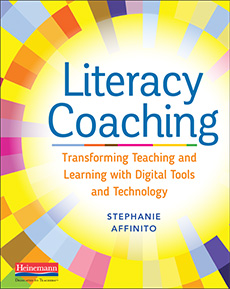Adding Digital Strategies to Literacy Coaching
Literacy Coaching: Transforming Teaching and Learning with Digital Tools and Technology
By Stephanie Affinito
(Heinemann, 2018 – Learn more)
Though Stephanie Affinito’s book Literacy Coaching: Transforming Teaching and Learning with Digital Tools and Technology is written with the intention of guiding the work of literacy coaches, it also offers wonderful ideas and tools for classroom teachers who do literacy instruction.

Establishing a learning community
Chapter 2, “Innovate Teacher Learning Communities,” delves into the importance of establishing a culture of sharing best practices, professional reading, and personal reading.
“Essentially, a teacher learning community is a dedicated group of teachers who work collaboratively to pursue goals related to teaching and learning. These groups are teacher driven in the spirit of inquiry, not as a mandate from above, and they support teacher development and quality” (page 20).
Dr. Affinito highlights the ideas of continuous learning, collaboration, respect for each other as educators, and designing pathways for personalized learning, “offering possible ways our traditional methods of building teacher learning communities might expand with the use of digital tools” (page 21, figure 2.2 on page 22).
Throughout this book, Affinito has spotlighted “Tech Tools,” providing the name of the tool, a website for use, if there is a cost, and a “Techspert Level” which gives the reader an idea of ease of use. Through the use of QR codes, Affinito adds more examples of blogs, tools, Padlets, etc, offering many possibilities to enhance our literacy practice as well as to share our own reading lives among colleagues and in the classroom with our students.
Fresh approaches to professional development
I’ve had the pleasure of participating in workshops led by Affinito, so when I read chapter 3, “Redesign Professional Development,” it hit home with me. Her approach to professional learning is powerful not only in engaging the teacher in the moment, but also in offering tools that can be taken and used immediately in the classroom.
Professional development needs to be thoughtful and strategic, always focused on the value it can add to the classroom. Literacy coaches need to be mindful of presenting and collaborating with teachers in a manner that is respectful of all educators’ time, and this chapter realistically outlines ways to make this happen.
Innovative collaboration
Chapters 4 and 5 offer valuable tools and practices that can bolster collaboration and provide transformative pathways into a 21st century literacy practice. Collaboration is a key factor for success in our schools and has grown into digital sharing globally as more professionals are engaged on social media, exchanging ideas and supporting each other as educators. Affinito compares traditional tools and digital tools of collaboration, always emphasizing working together in innovative ways.
“Literacy today looks different than it did twenty years ago. In fact, literacy today looks different than it did one year ago! Education within the twenty-first century requires that we continually reimagine our definition of literacy and literacy instruction in the classroom” (page 9).
A plan for growth
Chapter 5, “Find Inspiration,” offers advice on how to move forward as you reflect on this book, with the focus on nurturing your personal learning, allowing you to collaborate and grow with others. Again, while this book was written for literacy coaches, much of the content directly relates to those of us who are primarily classroom teachers.
This chapter also discusses choosing digital tools intentionally and strategically, which to me aligns with using best practices. What we choose to use must help us expand our literacy practices as well as our skill of collaboration. Educators must also realize the importance of being digitally responsible, which means working safely within the digital world and being able to model this to our students.
A resource guide to revisit often
Finally, throughout this book Affinito provides a tremendous number of links, apps, and tools. In addition, appendices offer templates for planning and collaborating, as well as a website to download full-size versions of materials.
As I’ve mentioned, I have had the pleasure of attending workshops led by Dr. Affinito and have left with tools that I’ve immediately implemented in my classroom. After reading this book, I’ve realized as a classroom teacher that I now have a resource guide that I will revisit often as I continue in my quest to transform my teaching practices using technologies that boost learning for today’s kids.
Kathleen Palmieri is a fifth grade teacher in upstate New York. With a passion for literacy and learning in the classroom, she participates in various writing workshops and curriculum writing endeavors. As a lifelong learner, she is an avid reader and researcher of educational practices and techniques. Collaborating with colleagues and globally on Twitter @Kathie042500 is an ongoing practice.




































